One reason that deserts tend to be found at 30°N and 30°S latitudes is that:
a)deserts are dry.
b)it’s warmer near the equator.
c)global wind and pressure patterns affect where rain falls.
d)desert soils are different from tropical rainforest soils.
e)mountains change rainfall patterns.
c) global wind and pressure patterns affect where rain falls
Which of the following is not an abiotic factor that organisms could come into contact with?
a)salinity
b)temperature
c)sunlight
d)bacteria
e)oxygen
d) bacteria
Population ecologists are primarily interested in:
a)understanding how biotic and abiotic factors influence populations and how they change.
b)the overall vitality of a population of organisms.
c)how humans affect the size of wild populations of organisms.
d)studying interactions among populations of organisms that inhabit the same area.
e)how populations evolve as natural selection acts on heritable variations among individuals and changes in gene frequency.
a)understanding how biotic and abiotic factors influence populations and how they change.
Ecosystem ecology emphasizes:
a)movement of energy and cycling of chemicals between organisms.
b)movement of energy and cycling of chemicals between organisms and the environment.
c)factors that affect population size and how and why this changes over time.
d)factors controlling the exchange of energy, materials, and organisms across multiple ecosystems.
e)how an organism’s structure, physiology, and behavior allow it to survive.
b) movement of energy and cycling of chemicals between organisms and the environment.
If you were hiking up a mountain, you might observe transitions in biological communities or habitats that are analogous to the changes:
a)in biomes at different latitudes.
b)in different depths in the ocean.
c)in a community through different seasons.
d)in an ecosystem as it evolves over time.
a) in biomes at different latitudes.
What is a disturbance?
an event such as a storm, fire, or human activity that changes a community
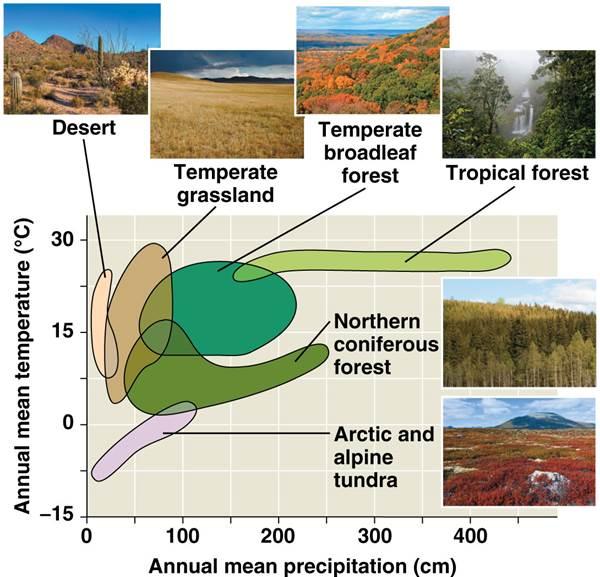
The climograph shows that:
a)biomes exist in distinct annual temperature and precipitation ranges and do not overlap.
b)biomes are controlled more by annual mean temperature than
by
annual mean precipitation.
c)tropical forests span the largest precipitation range of any biome.
d)deserts span the largest temperature range of any biome.
e)the largest biome on Earth, in area, is the temperate grassland.
c) tropical forests span the largest precipitation range of any biome.

The climograph shows that:
a)most biomes require at least an average of 200 cm of
precipitation
per year.
b)most biomes require at least an average annual temperature of 20°C.
c)no biomes exist below 0°C.
d)the desert biome exists within the most wide range of annual mean precipitation on Earth.
e)temperate grasslands exist within the most wide range of annual mean temperature on Earth.
e) temperate grasslands exist within the most wide range of annual mean temperature on Earth.
Biotic factors that affect the distribution of organisms may include:
- Predation
- Herbivory
- Competition
- Mutualism
- Parasitism
Abiotic factors affecting the distribution of organisms include:
- Temperature
- Water
- Oxygen
- Salinity
- Sunlight
- Soil
Most abiotic factors vary in space and time
Seasons on Earth in the Northern and Southern Hemispheres are caused by:
a)the distance from the Earth to the sun changing over the course of a year.
b)a change in the angle of tilt of Earth’s axis throughout the year.
c)the angle of the sun’s rays striking Earth changing as the Earth orbits the sun with a constant tilt.
d)the rotation of the Earth on its own axis.
e)a combination of b and e
c) the angle of the sun’s rays striking Earth changing as the Earth orbits the sun with a constant tilt.
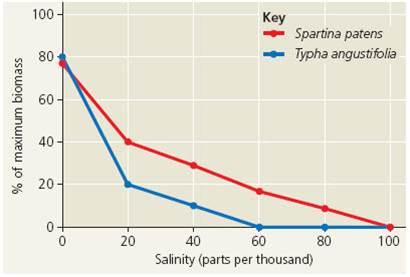
Based purely on the results shown below, at what range of salinities would you expect to find S. patens in the field but not T. angustifolia?
a)Only S. patens would grow at salinities between 60
and
100 parts per thousand.
b)Only S. patens would grow at salinities between 0 and 100 parts per thousand.
c)Only S. patens would grow at salinities between 0 and
60
parts per thousand.
a) Only S. patens would grow at salinities between 60
and
100 parts per thousand.
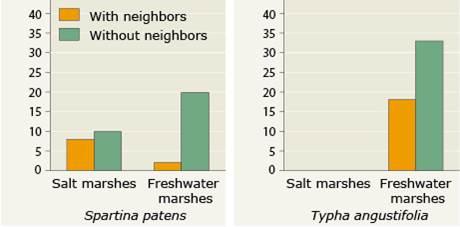
The lowest salinity level in the greenhouse mimics a freshwater marsh. In the field, S. patens is typically absent from natural freshwater marshes. Based on the data, does this appear to be due to salinity or competition?
a)Competition; at zero salinity, the % of maximum biomass was higher for T. angustifolia than for S. patens, showing that S. patens would not compete as well in fresh water.
b)Competition; it can grow in zero salinity in experimental freshwater marshes without competing neighbors but has reduced biomass in the presence of neighbors.
c)Salinity; S. patens can grow in experimental salt
marshes, but
T. angustifolia cannot.
d)Salinity; S. patens had less biomass in experimental fresh marshes than in salt marshes.
b) Competition; it can grow in zero salinity in experimental freshwater marshes without competing neighbors but has reduced biomass in the presence of neighbors.

T. angustifolia is not present in natural salt marshes. Does this appear to be due to salinity or competition?
a)Salinity; it is absent from experimental salt marshes
even
without competing neighbors, and it did not grow in the higher
salinity levels in the greenhouse.
b)Salinity; it is not present in salt marshes.
c)Competition; it grows better without competing neighbors than with them in the experimental marsh.
d)Competition; S. patens grows better than T. angustifolia in experimental salt marshes and therefore must outcompete it.
a)Salinity; it is absent from experimental salt marshes
even
without competing neighbors, and it did not grow in the higher
salinity levels in the greenhouse.
Oligotrophic lakes are
- nutrient-poor and generally oxygen-rich
- Oligotrophic lakes have less surface area relative to depth than eutrophic lakes
Eutrophic lakes are
nutrient-rich and often depleted of oxygen in deep zones or throughout if ice covered in winter
Eutrophication:
nutrients added to a lake to make it eutrophic (causes algal blooms, eventually removing all oxygen from lake, killing larger organisms)
Commensalism is ________.
(+/0 interaction) is an interaction in which one species benefits and the other is neither harmed nor helped
Ex: An egret eats insects stirred up by grazing animals
Mutualism is ____.
(+/+ interaction) is a common interspecific interaction that benefits both species
Ex: Humans who have pets tend to be healthier than humans who do not have pets.
Positive Interactions are those where _____.
at least one species benefits and neither is harmed
Ex: Mutualism (+/+ )and Commensalism (+/0)
Parasites that live outside of the body of their host are called _____.
Ectoparasites
Parasites that live within the body of their host are called _____.
Endoparasites
Parasitism is ___.
(+/– interaction), one organism, the parasite, derives nourishment from another organism, its host, which is harmed in the process
Ex: the relationship between a dog and a blood-sucking tick
Resource Partitioning is _______.
differentiation of ecological niches, enabling similar species to coexist in a community
Herbivory is _____.
(+/– interaction) refers to an interaction in which an herbivore eats parts of a plant or alga
Competition is _____.
(–/– interaction) occurs when species compete for a
resource that limits survival and reproduction
Resources must be
in short supply for competition to occur
Ex: both humans and sharks eat fish
Predation is _____.
(+/– interaction) refers to an interaction in which one species, the predator, kills and eats the other, the prey
Ex: human eats a deer
Müllerian mimicry is _____.
When two or more unpalatable species resemble each other
Batesian mimicry is _____.
When a palatable or harmless species mimics an unpalatable or harmful model
Cryptic coloration is ______.
Camouflage; makes prey difficult to spot
Character displacement is _____.
the tendency of characteristics to diverge more in sympatric than in allopatric populations.
The order of the stages of primary succession beginning with glacial retreat as seen at Glacier Bay, Alaska, are ________.
Pioneer, Dryas, Alder, and Spruce stages
A zoonotic pathogen is _________.
transferred to humans from other animals
Semelparity describes _____.
an organism that only reproduces once in its lifetime
Iteroparity describes _____.
an organism that reproduces multiple times in its lifetime
What does a negative population growth rate tell you about the dynamics of the population?
- The population size is increasing instead of decreasing.
- The population size is decreasing instead of increasing.
- The birth rate equals the death rate.
b.) The population size is decreasing instead of increasing.
If rmax is doubled, how would the population growth rates change?
- The population growth rates would be unchanged.
- The population growth rates would be four times what they were.
- The population growth rates would double.
- The population growth rates would be half of what they were
c.) The population growth rates would double
Primary producers are _____.
Autotrophs
A measure of the total biomass accumulation during a given period of time is called the _________.
Net Ecosystem Production
Detritivores are _________.
Heterotrophs
A measure of the total primary production in an ecosystem is called the _________.
Gross Primary Production
The percentage of production transferred from one trophic level to the next-higher level is called ________.
Trophic efficiency
The percentage of energy stored in assimilated food that is not used for respiration is the _________.
Production efficiency
Biological augmentation is a process that _________.
uses organisms to add essential materials to a degraded ecosystem
A measure of production that is calculated by subtracting autotrophic respiration from all primary production in an ecosystem is called _________.
Net Primary Production
The region that transitions between a river and the sea is called a(n) __________.
Estuary
Rooted plants are found only in the _____ zone of a lake.
Littoral
A thermocline is a ____________.
narrow layer of abrupt temperature change in most lakes and the ocean
A _________ compares annual temperatures and rainfall in different _________.
Climograph; biomes
Zonation in aquatic zones includes all of the following except the ________ zone.
- littoral
- abyssal
- detritus
- pelagic
- photic
Detritus
The region that is characterized by a vast realm of open, blue water is called the _________ zone.
oceanic pelagic
The region that is periodically submerged between the land and the ocean is called the _________ zone.
Intertidal
An antagonistic social interaction used to defend a bounded physical space is called __________.
Territoriality
An oak tree produces thousands of acorns, but very few grow into mature oak trees. The oak tree exhibits a __________ survivorship curve.
Type III
A population that is growing logistically __________.
Grows fastest at an intermediate population density
Assuming that r has a positive value, in the formula dN/dt = rmaxN (K - N)/K, the factor rN tends to cause the population to __________.
Grow increasingly rapidly
The concept that summarizes the aggregate land and water area required by each person to produce all resources he or she needs and absorb all waste he or she produces is called the _________.
An ecological footprint
Organisms that live in a homogenous abiotic environment and cooperate to avoid being eaten would likely show a(n) __________ pattern of dispersion.
Clumped
Life history traits that are favored in uncrowded environments are known as _________.
r-selection
Life history traits that are favored at high population densities are known as _________.
K-selection
A survivorship curve that represents high death rates for the young is a ________ curve.
Type III
A group of individuals of a single species living in the same general area is called a _________.
Population
A graph that plots the numbers of individuals who are alive at particular ages is called _________.
a survivorship curve
A graph of the number of individuals per unit area or volume is called a ____.
Density curve
A summary of the survival pattern of a population and not a graph is called a _____.
A life table
A group of individuals of the same age, from birth until all the individuals are dead is called a ____.
Cohort
The study of vital statistics of populations and how those statistics change over time is known as____.
Demography
Mechanisms of density-dependent selection include all of the following except _______.
- disease
- the size of the brood
- predation
- competition for resources
- territoriality
The size of the brood
The pattern of spacing among individuals within the boundaries of the population is known as _____.
Dispersion
The number of individuals per unit area or volume is known as _____.
Density
The difference between density and dispersion is that __________.
Density is the number of individuals per unit area or volume. Dispersion is the pattern of spacing among individuals within the boundaries of the population. Density is the overall concentration and dispersion is the spread of the concentration.
Fluctuations in the numbers of individuals in a population from year to year are called _________.
Population dynamics
The difference between immigration and emigration is that _________.
Immigration is the influx of new individuals from other areas whereas emigration is the movement of individuals out of a population
The movement of individuals or gametes away from centers of high population density or from their area of origin is called _____.
Dispersal
- Dispersal contributes to the global distribution of organisms
What are the five biotic factors that affect the distribution of organisms?
- Predation
- Herbivory
- Competition
- Mutualism
- Parasitism
Abiotic factors affecting the distribution of organisms include:
- Temperature
- Water
- Oxygen
- Salinity
- Sunlight
- Soil
- Most abiotic factors vary in space and time
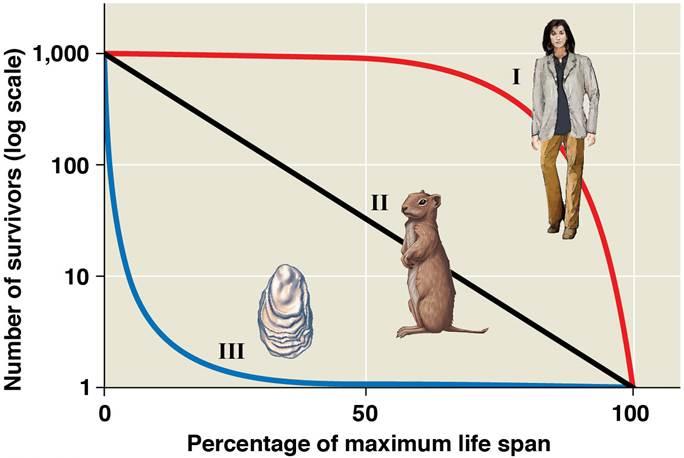
Imagine that a species of fish used to be a broadcast spawner (producing many eggs that then get no subsequent parental care) but has evolved to be a mouthbrooder (holding the eggs in the parent’s mouth until they hatch and then caring for the young for a while). We would expect the survivorship curve of this species to:
- shift from Type I to Type II or III.
- shift from Type II to Type I.
- shift from Type III to
Type I or II. - shift from Type II to Type III.
- vary unpredictably.
a) shift from Type III to Type I or II.
Population ecologists are primarily interested in
a)understanding how biotic and abiotic factors influence the density, distribution, size, and age structure of populations.
b)the overall vitality of a population of organisms.
c)how humans affect the size of wild populations of organisms.
d)studying interactions among populations of organisms that inhabit the same area.
e)how populations evolve as natural selection acts on heritable variations among individuals and changes in gene frequency.
a) understanding how biotic and abiotic factors influence
the
density, distribution, size, and age structure of populations.
Low death rates during early and middle life and an increase in death rates among older age groups.
Type I
Survivorship Curve
A constant death rate over the organism’s lifespan.
Type II
Survivorship Curve
High death rates for the young and a lower death rate for survivors.
Type III
Survivorship Curve
An organism’s life history entails what three key components?
- The age at first reproduction (maturity)
- How often the organism reproduces
- How many offspring are produced per reproductive episode
In ____________ populations, birth rate and death rate do not change with population density.
Density-independent
In ____________ populations, birth rates fall and death increase with rising population density.
Density-dependent
- Only density-dependent factors can regulate population size
Density-dependent birth and death rates are affected by many factors, such as:
- Competition for resources
- Disease
- Predation
- Territoriality
- Toxic wastes
- Intrinsic factors
_________ are an example of negative feedback that regulates population growth
Density-dependent birth and death rates
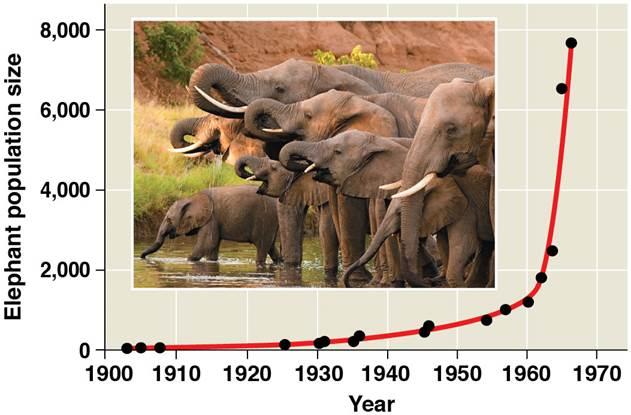
The exponential growth model describes the increase in population size of a population that is not constrained by resources or space. The graph shows the elephant population in Kruger National Park, which appears to have been increasing exponentially from 1900 to 1965. From this graph, you can tell that:
- none of the elephants died.
- a female elephant living
around 1960 was more likely to have a
baby than a female elephant living around 1920. - the elephants adapted to the new park conditions around 1955.
- the vegetation the elephants eat could support more than 5,000 elephants.
- the more elephants there are, the more tourists will visit the park.
a)the vegetation the elephants eat could support more
than
5,000 elephants.
You do a study on elephants and find that there are eight elephants per acre. This is a measurement of:
a)density.
b)dispersal.
c)demographics.
d)survivorship.
a) Density
The European starling made it to the Atlantic coast of North America over 100 years ago. Fifty years after that, the bird was found in many states throughout the Midwest. This is an example of:
a)density.
b)disturbance.
c)demographics.
d)survivorship.
e)dispersion.
e) Dispersion
A population of deer grows from 100 to 200 to 600, and when it gets to 600, it levels off. This population must have reached:
a)exponential growth.
b)carrying capacity.
c)logistic growth.
d)exponential capacity.
e)unlimited resources.
b) Carrying Capacity
What is the difference between semelparity and iteroparity?
a)Semelparous organisms return to their place of birth to reproduce, but iteroparous organisms can reproduce anywhere.
b)Semelparous refers only to plants, but iteroparous refers to animals.
c)Semelparous organisms live after their first reproduction, but iteroparous organisms die.
d)Semelparous organisms die after their first reproduction,
but iteroparous organisms are capable of repeated reproduction.
d) Semelparous organisms die after their first reproduction,
but iteroparous organisms are capable of repeated reproduction.
What does a negative population growth rate tell you about the dynamics of the population?
a)The birth rate equals the death rate.
b)The population size is increasing instead of decreasing.
c)The population size is decreasing instead of increasing.
d)The population is not experiencing competition.
e)The population is not limited by resources.
c) The population is decreasing instead of increasing
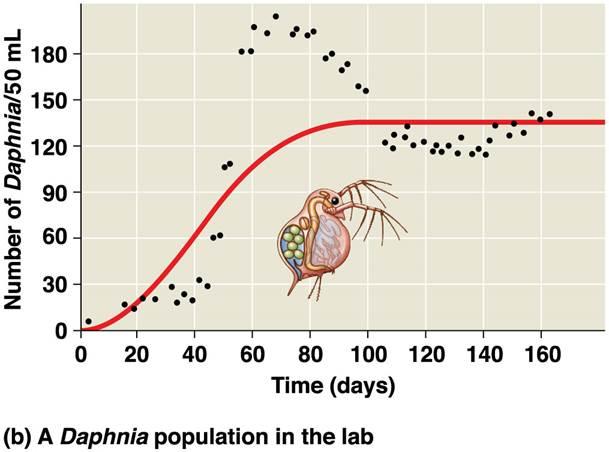
The red line shows the growth predicted by the logistic model, and the black dots show the measured growth of the population. Does the measured growth match the predicted growth pattern?
a)No; only a few of the black dots sit on the red line.
b)Yes; it matches at the beginning and at the end of the time range.
c)No; it is lower than the predicted values in some parts
and
higher in other parts.
d)Yes; it matches over the whole
time range.
c) No; it is lower than the predicted values in some parts
and
higher in other parts.

What is the predicted carrying capacity of the Daphnia culture?
a)120 Daphnia/50 mL
b)135 Daphnia/50 mL
c)200 Daphnia/50 mL
d)300 Daphnia/50 mL
e)190 Daphnia/50 mL
b) 135 Daphina/50 mL
Did the Daphnia population ever experience a negative growth rate?
a)From about day 70 to day 105, the population decreased in size, indicating a negative growth rate.
b)The population never experienced a negative growth rate because it stabilized after 140 days and never went to zero.
c)From about day 20 to day 50 and from day 100 to day 150, the population fell below the predicted values, indicating a negative growth rate.
a) From about day 70 to day 105, the population decreased
in
size, indicating a negative growth rate
What is the best biological explanation for why the Daphnia population growth rate became negative between days 70 and 105?
a)The population’s data defined by the black dots have a slope that is negative during that period.
b)The population grew larger than the predicted size during that period.
c)The population exceeded the carrying capacity and started running out of resources during that period.
d)The population’s death rate was greater than the birth rate during that period.
c) The population exceeded the carrying capacity and
started
running out of resources during that period.
How does emigration affect population size?
a)The population will increase in size as emigration increases.
b)The population can experience loss of individuals who
move
to other regions.
c)The population gains individuals due to births.
d) It changes whether the organism shows a random or uniform distribution.
e)It causes the population to shift from a clumped to a uniform pattern of dispersion.
b) The population can experience loss of individuals who
move
to other regions.
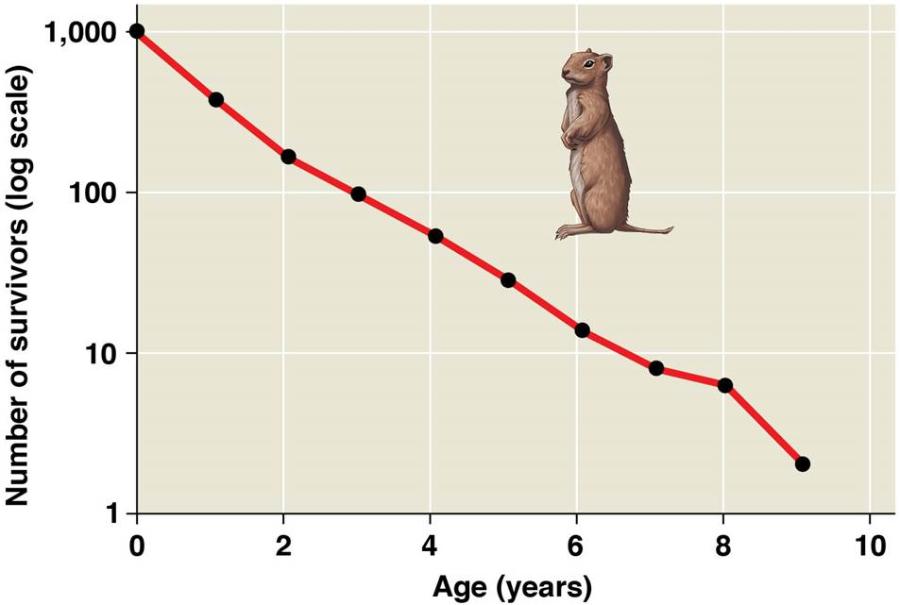
What percentage of female ground squirrels in the diagram below survive to 7 years old?
a)10%
b)100%
c)1%
d)25%
e)50%
c) 1%
Female sea turtles emerge from the ocean and crawl up the beach, lay about 100 eggs or more per nest, and then cover the eggs with sand. What can you conclude about sea turtle populations?
a)The population will increase in size rapidly due to a high reproductive rate.
b)The population would exhibit a Type I survivorship curve if graphed.
c)The population exhibits high mortality among older age classes.
d)The population relies on parental care.
e)The population exhibits high mortality among young individuals.
e) The population exhibits high mortality among young individuals.
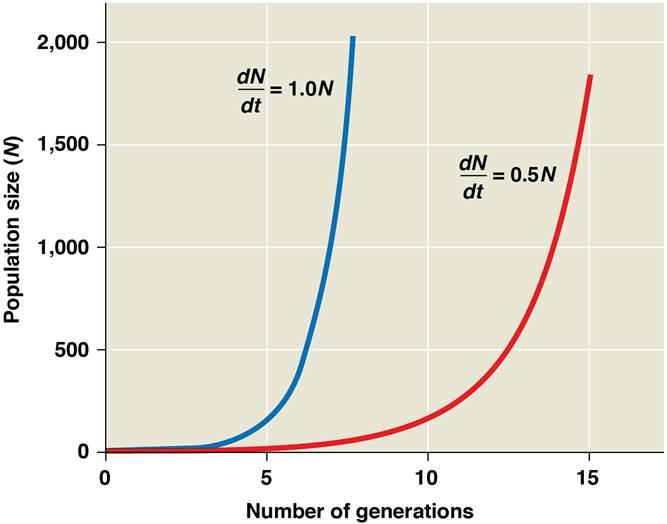
Which of the following statements about the graph below, which shows the increase in numbers of two populations of a species is correct?
a)It shows rapid, logistic growth only in one population.
b)It shows that the carrying capacity of the two different populations are different.
c)The red population (dN / dt = 0.5N) is larger because it continues for more generations.
d)Each population size is calculated in an instantaneous manner by considering current size and rate of increase.
d) Each population size is calculated in an instantaneous manner by considering current size and rate of increase.
Which variables define the ecological life history of a species?
A) the age at which reproduction begins, the frequency of reproduction, and the number of offspring for each reproductive episode
B) the ratio of females to males, the length of the breeding season, and the number of offspring for each reproductive episode
C) the number of offspring produced over a lifetime by a breeding pair and the survivability of the offspring
D) timing breeding sessions with optimal environmental conditions and the number of offspring produced during each breeding session
E) the amount of parental care given after birth, the number of reproductive episodes per year, and the number of years females are capable of producing viable offspring
A) the age at which reproduction begins
the frequency of reproduction, and
the number of offspring for each reproductive episode
A species’ ________ is the niche potentially occupied by that species, while a species’ ________ is the niche actually occupied by that species
Fundamental; realized
The tendency for characteristics to be more divergent in sympatric populations of two species than in allopatric populations of the same two species is called _____?
Character Displacement
Animals with effective chemical defenses often exhibit bright warning coloration, called _____.
Aposematic coloration
Two-species interactions are classified by the impact each species has on the other. Thus, a competitive interaction is one where the populations of each species are negatively impacted by the presence of the other species, usually because each species uses the same resources. Niche partitioning enables species to coexist by:
- avoiding direct competition.
- encouraging mutualistic interactions.
- enabling prey to hide from predators.
- creating new resources.
- allowing abiotic factors, such as climate or nutrient availability, to influence the community.
a) avoiding direct competition.
Which of the following best describes resource partitioning?
a)Two species can coevolve to share identical niches.
b)Competitive exclusion results in the success of the superior species.
c)A climax community is reached when no new niches are available.
d)Slight variations in niche allow similar species to
coexist.
e)Differential resource utilization results in the decrease in community species diversity.
d) Slight variations in niche allow similar species to
coexist.
What is one difference between the fundamental niche and the realized niche?
a)The realized niche is larger.
b)The fundamental niche is determined by competitors.
c)The realized niche is determined by abiotic resources.
d)Individuals will be found only in the realized niche.
e)The difference is called the occupied niche.
d) Individuals will be found only in the realized niche.
How might an ecologist test whether a species is occupying all of its fundamental niche or only a portion of it?
a)Observe if the niche size changes after the introduction of a similar species.
b)Measure the change in reproductive success when the species is subjected to environmental stress.
c)Observe if the species expands its range after the
removal
of a competitor.
d)Study the temperature range and humidity requirements of the species.
c) Observe if the species expands its range after the
removal
of a competitor.
If two species are close competitors, and one species is experimentally removed from the community, the remaining species would be expected to _____.
a)change its fundamental niche
b)decline in abundance
c)become the target of specialized parasites
d)expand its realized niche
d) expand its realized niche
The common spiny mouse (Acomys cahirinus) and the golden spiny mouse (A. russatus) can occupy essentially the same ecological niche in rocky habitats of the Middle East and China. They accomplish this by:
- character displacement.
- temporal niche partitioning.
- eating different foods.
- mating at different times of the year.
- each occupying their functional niche.
b) temporal niche partitioning.
Character displacement:
a)can be observed in sympatric populations of two
species.
b)is usually observed in allopatric populations of two species.
c)is usually observed for two species living in widely separated habitats.
d)is the result of niche partitioning.
e)is an interaction between two species in which one generally dominates the competition due to its morphology.
a) can be observed in sympatric populations of two
species.
An obligate mutualism is an interaction in which at least one species cannot survive without the presence of the other species; a facultative mutualism is an interaction that benefits both species but is not required by either species. One reason facultative mutualism is more common is that:
- in a facultative mutualism, if the partner becomes extinct, the obligate mutualist will also become extinct.
- in an obligate mutualism, the obligate mutualist is obliged to support its partner.
- in a facultative mutualism, neither partner can depend on the other partner.
- facultative mutualisms require longer periods of time to evolve.
- in an obligate mutualism,
if the partner becomes extinct,
the obligate mutualist will also become extinct.
e) in an obligate mutualism if the partner becomes extinct,
the
obligate mutualist will also become extinct.
The number of different species in the community is known as ____.
Species Richness
The proportion each species represents of all individuals in the community is the _____.
Relative abundance
The feeding relationships between organisms in a community is the ____.
Trophic structure
The evaporation of water from soil plus transpiration of water from plants is called _____.
Evapotranspiration
- is how water returns to the atmosphere during the water cycle
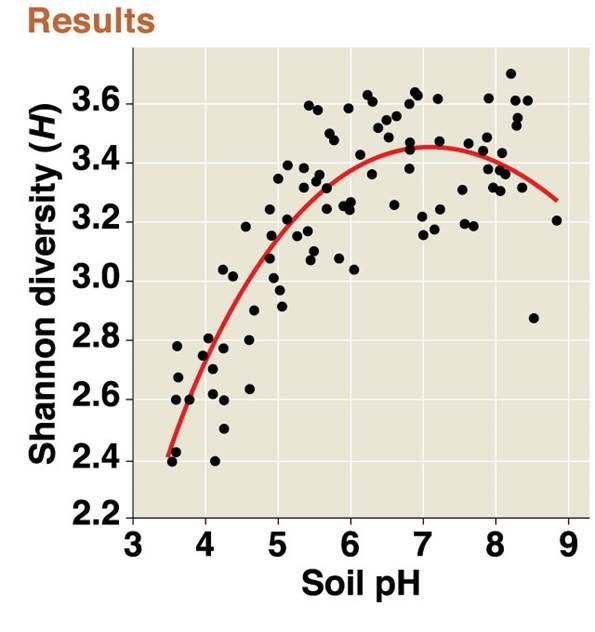
This graph shows the effect of soil pH on microbial diversity. One conclusion you should draw from this figure is:
- the higher the soil pH, the higher the microbial diversity.
- the lower the soil pH, the higher the microbial diversity.
- microbes do not exist in acidic conditions.
- the scientists couldn’t find any acidic or basic soils.
- there appears to be an optimal pH value for
maximizing
microbial diversity.
there appears to be an optimal pH value for maximizing microbial diversity
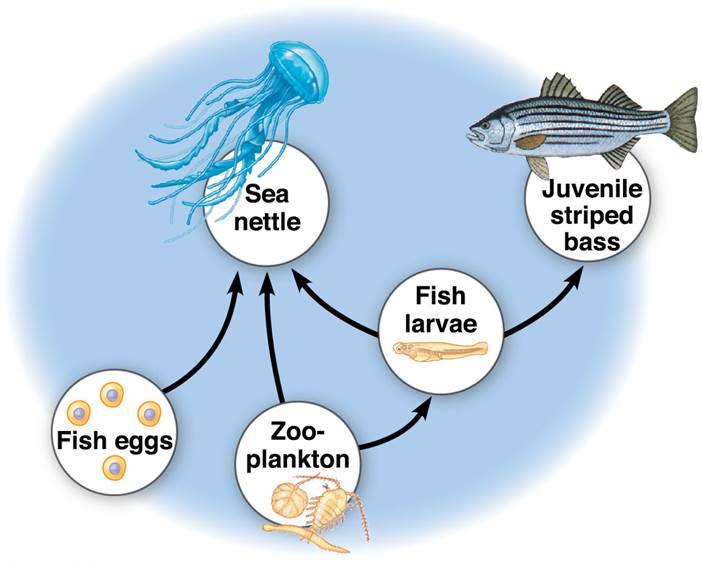
Look at the following figure, which shows a partial Chesapeake Bay food web. If sea nettles disappeared,
a)there would be fewer fish eggs.
b)there would be more striped bass.
c)there would be fewer zooplankton.
d)striped bass would have less food to eat.
e)fish larvae would decrease in abundance.
b) there would be more striped bass.
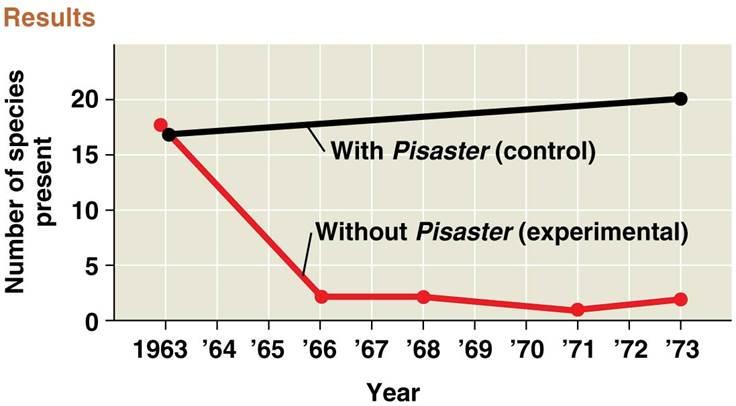
In rocky intertidal communities of western North America, Robert Paine removed Pisaster, an uncommon starfish, and measured species diversity. He found that species diversity dropped dramatically when Pisaster was not present. From this, we can conclude that:
- uncommon species are more vital to the community than common species.
- predators are more vital to the community than prey.
- Pisaster likely consumed the dominant competitors.
- Robert Paine’s experiment was poorly designed.
- removing one species always hurts the community.
c) Pisaster likely consumed the dominant competitors.
Disturbance is an important component of succession because it:
a)removes keystone species.
b)changes the biome from one kind to another.
c)introduces invasive species.
d)is associated with humans.
e)tends to promote earlier successional stages.
e) tends to promote earlier successional stages
Disturbance is hypothesized to be the most beneficial in terms of increasing biodiversity at:
a)low levels.
b)high levels.
c)random intervals.
d)moderate levels.
e)intense levels.
d) Moderate levels
A unidirectional influence on biomass from lower to higher trophic levels is called:
a)an intermediate control.
b)a bottom-up model.
c)a top-down model.
d)a restored state.
b) a bottom-up model
Some birds follow moving swarms of army ants in the tropics. As the ants march along the forest floor hunting insects and small vertebrates, birds follow and pick off any insects or small vertebrates that fly or jump out of the way of the ants. This situation is an example of what kind of species interaction between the birds and the ants?
- parasitism
- mutualism
- commensalism
- predation
c) commensalism
Which of the following defines mutualism:
a)−/−
b)+/−
c)+/+
d)+/0
e)0/0
Answer: c. Mutualism is a relationship in which both organisms benefit from the relationship.
Plants growing beneath and completely dependent upon the shade and dim light provided by the canopy of tall trees is an example of which kind of species interaction?
a)ammensalism
b)mutualism
c)commensalism
d)parasitism
e)competition
c) Commensalism
Which of the following terms is used by ecologists to describe the community interaction where one organism makes the environment more suitable for another organism?
A) parasitism
B) mutualism
C) inhibition
D)
facilitation
E) commensalism
D) facilitation
The energetic hypothesis and dynamic stability hypothesis are ideas that attempt to explain:
A) plant defenses against herbivores.
B) the length of food
chains.
C) the evolution of mutualism.
D) resource
partitioning.
E) competitive exclusion.
B) the length of food chains
The amount of light energy converted to chemical energy by autotrophs during a given time period is _____.
Primary Production
__________ build molecules themselves using photosynthesis or chemosynthesis as an energy source.
Autotrophs
_____________ depend on the biosynthetic output of other organisms
Heterotrophs
Primary producers are _______.
Autotrophs
Primary consumers are _________.
Herbivores
Secondary consumers are _________.
Carnivores
Tertiary consumers are ________.
Carnivores that feed on other carnivores
Detritivores are ______.
heterotrophs that derive their energy from detritus, nonliving organic matter
AKA: decomposers
The total primary production is known as the ecosystem’s _____.
Gross Primary Production (GPP)
__________ is GPP minus energy used by autotrophs for respiration (Ra).
Net Primary Production (NPP)
NPP represents new biomass added to the whole ecosystem during a given time
NPP = GPP – Ra
___________ is a measure of the total biomass (not just biomass of producers) accumulation during a given period
Net Ecosystem Production (NEP)
- NEP is gross primary production minus the total respiration of all organisms (RT) in an ecosystem
NEP = GPP – RT
In marine and freshwater ecosystems, both _____ and______ control primary production.
light; nutrients
_______ is the element that must be added for production to increase in an area.
Limiting nutrient
________and ________ are the nutrients that most often limit marine production.
Nitrogen; phosphorous
Experiments in the Sargasso Sea in the subtropical Atlantic Ocean showed that the micronutrient _________ can also limit primary production
Iron
In terrestrial ecosystems, __________ and ___________affect primary production on a large scale.
Temperature; moisture
________ production of an ecosystem is the amount of chemical energy in food converted to new biomass during a given period of time.
Secondary
What is the most important role of photosynthetic organisms in an ecosystem?
a)converting inorganic compounds into organic
compounds
b)absorbing solar radiation
c)producing organic detritus for decomposers
d)dissipating heat
e)recycling energy from other trophic levels
a) converting inorganic compounds into organic
compounds
The first law of thermodynamics:
a)states that energy can be destroyed.
b)states that energy can be created.
c)states that energy can be transformed and transferred
but
not created or destroyed.
d)states that the total energy in a system will decrease as energy is used up.
e)states that energy is cycled within an ecosystem.
c) states that energy can be transformed and transferred but
not
created or destroyed.
Imagine that an arctic fox has just captured its prey, an arctic sea bird, and begins to consume it. In what way will the energy in the bird be transferred or transformed?
- The flesh of the bird
will be digested and the organic
molecules of fats, proteins, etc. will be absorbed and
delivered by the fox’s blood vessels to cells. - The bonds in the organic molecules of energy found in the flesh of the bird will be broken down and will generate both ATP and heat.
- The energy held within the flesh of the bird will enter and remain in the fox forever.
- both a and b
d) both a and b
Which of the following is accurate regarding the second law of thermodynamics?
a)As energy is transferred or transformed, a certain portion of the energy is destroyed.
b)Energy will not cycle within an ecosystem for very long,
and
much of the total energy entering will be lost as heat
.
c)Energy cycles within an ecosystem for long periods of time.
d)Incoming solar radiation energy will all be absorbed by plants during photosynthesis.
b) Energy will not cycle within an ecosystem for very long,
and
much of the total energy entering will be lost as
heat.
Following the second law of thermodynamics, what is inefficient about the fox eating the arctic bird?
a)The bird’s energy will only last so long.
b)Although all the energy in organic bonds of the flesh of
the bird is transferred to the fox, cool temperatures require
constant predation.
c)Some of the energy consumed by the fox will be used to generate
ATP in its cells, but another portion of the
energy will be lost
as heat.
d)Nothing is inefficient about it.
c) Some of the energy consumed by the fox will be used to generate
ATP in its cells, but another portion of the
energy will be
lost as heat.
Unlike energy, matter cycles within and among ecosystems. This means that:
a)an ecosystem cannot lose chemicals from it.
b)ecosystems can acquire chemicals that are used up from other ecosystems.
c)when models are built for ecosystems, all of the
materials
should be accounted for.
d)matter is being continually converted into heat and back into matter.
e)chemicals contain energy, but energy doesn’t contain chemicals.
c) when models are built for ecosystems, all of the
materials
should be accounted for.
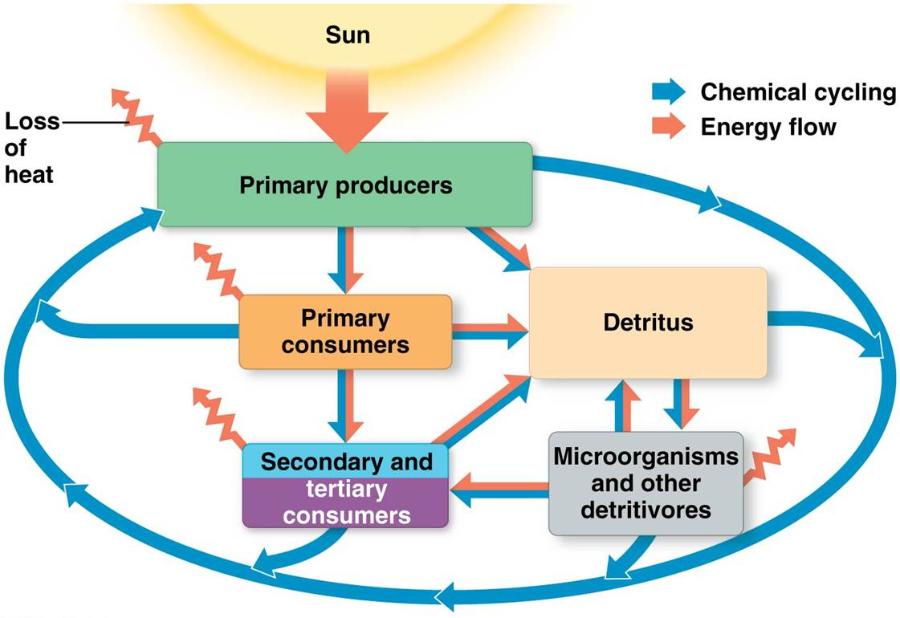
The source of the loss of heat from the primary producers and primary consumers shown below is heat produced during cellular respiration.
a) True
b) False
a) True
Gross primary productivity is higher than net primary productivity. The difference between the two is:
a)the amount of energy producers burn when they
metabolize.
b)typically the ratio between the biomass of producers and the biomass of consumers.
c)an important measure of ecosystem productivity.
d)energy that is lost into outer space due to metabolic inefficiencies.
e)energy that is stored in plant tissues.
a) the amount of energy producers burn when they
metabolize.
Why are big, predatory animals rare? Most big, predatory animals are tertiary consumers, which implies that:
a)they are typically highly territorial.
b)it’s hard for an ecosystem to support many of them
because
so much energy is lost at each level of energy exchange.
c)by overexploitation, humans have caused many predatory species to become endangered.
d)it takes a long time for big, predatory animals to evolve.
e)it’s hard for a big animal to move through dense vegetation.
b) it’s hard for an ecosystem to support many of them
because
so much energy is lost at each level of energy exchange.
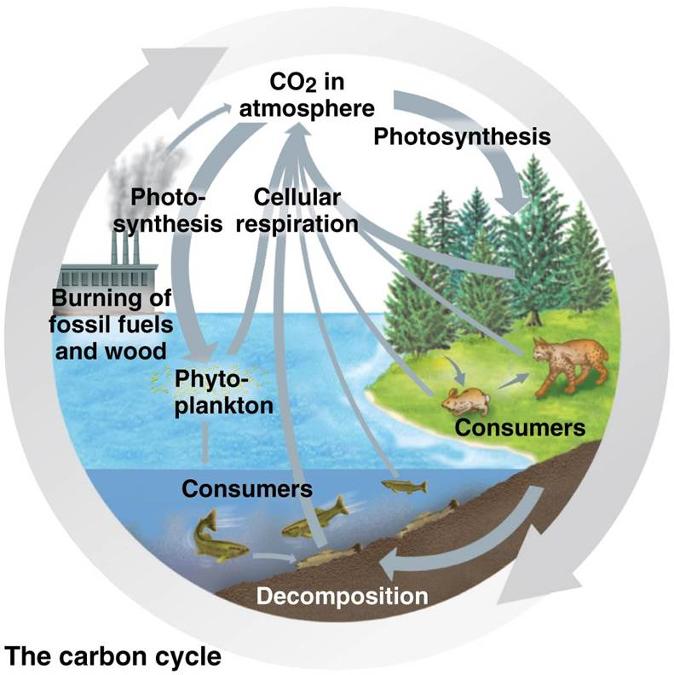
The diagram shows a general model of carbon cycling. All living things contribute to one or more components of this diagram. Which arrow(s) show(s) an activity or activities that is/are performed by every living thing?
- cellular respiration
- photosynthesis
- fossil fuel burning
- decomposition
- a and d
e) a and d
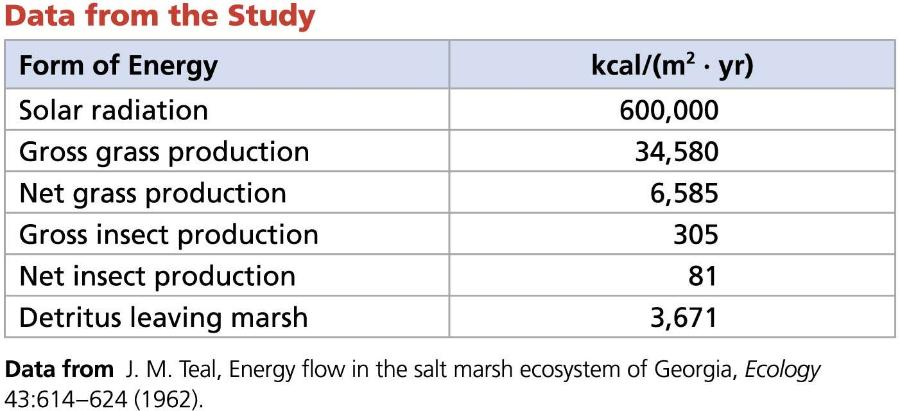
Why is there a difference between gross and net grass production?
a)Some of the grass died due to consumption.
b)Some energy was lost as heat during respiration.
b) Some energy was lost as heat during respiration.

What percentage of the solar energy that reaches the marsh is incorporated into gross primary production?
a)1.1%
b)5.8%
c)10.3%
d)62.4%
b) 5.8%

What percentage of the solar energy that reaches the marsh is incorporated into net primary production?
a)0.01%
b)0.2%
c)1.1%
d)12.3%
c) 1.1%

How much energy is lost by primary producers as respiration in this ecosystem?
a)3,921 kcal/(m2 • yr)
b)6,585 kcal/(m2 • yr)
c)13,735 kcal/(m2 • yr)
d)27,995 kcal/(m2 • yr)
d) 27,995 kcal/(m2 • yr)

How much energy is lost as respiration by the insect population?
a)16 kcal/(m2 • yr)
b)85 kcal/(m2 • yr)
c)224 kcal/(m2 • yr)
d)305 kcal/(m2 • yr)
c) 224 kcal/(m2 • yr)

If all of the detritus leaving the marsh is plant material, what percentage of all net primary production leaves the marsh as detritus each year?
a)8%
b)20%
c)43%
d)56%
d) 56%